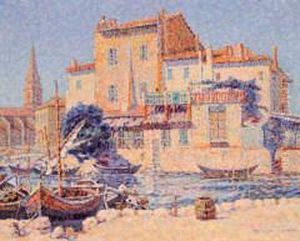Jean-Louis Aste Paintings
Jean-Louis Aste was a French artist born in 1781 in Nice, which was then part of the Kingdom of Sardinia but is now a part of France. Aste's work spanned the late 18th and early 19th centuries, a period that witnessed the tumultuous years of the French Revolution, the Napoleonic Wars, and the Restoration period. Despite the political upheavals of his time, Aste developed a style that was deeply rooted in the Neoclassical tradition, reflecting the influence of artists such as Jacques-Louis David and Jean-Auguste-Dominique Ingres. However, he also exhibited a keen interest in the Romantic movement that began to emerge in the early 19th century, making his body of work an interesting blend of tradition and innovation.
Throughout his career, Jean-Louis Aste was primarily known for his portrait paintings, through which he displayed a remarkable ability to capture the personality and essence of his subjects. His portraits are characterized by their refined elegance, meticulous detail, and the subtle interplay of light and shadow. Aste's skill in portraiture earned him commissions from many prominent figures of his time, including members of the nobility and the burgeoning bourgeoisie, who sought to have their likenesses captured for posterity.
In addition to portraits, Aste also produced historical paintings, landscapes, and religious works. His historical paintings often depicted key events from classical antiquity and the Renaissance, reflecting his deep admiration for the ideals of beauty and heroism that characterized these periods. His landscapes and religious paintings, on the other hand, reveal a more contemplative side of the artist, with a focus on the beauty of the natural world and the spiritual dimension of human experience.
Despite his considerable talent and the quality of his work, Jean-Louis Aste did not achieve the same level of fame as some of his contemporaries. Nevertheless, his contributions to the art world during a period of significant change and development were substantial. He continued to paint and exhibit his work until his death in 1859. Today, Aste's paintings can be found in museums and private collections, where they continue to be appreciated for their beauty and historical value. His legacy is that of a skilled artist who navigated the complexities of his era with a commitment to both tradition and innovation in his art.
